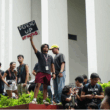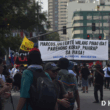Maguindanao was barely known to us until the massacre that killed 57 individuals, journalists and civilians included.
What really triggered the massacre is yet to be known. The past, however, may leak us some clues.
End of 15th century
- Islam was introduced in the Philippines and the Sultanate of Maguindanao was established.
- Sharif Sultan Muhammad bin Ali Zainal Abidin (Sharif Kabunsuan) was the first sultan.
1565
- The said start of the Mindanao conflict as the “moros” fought for ownership of their land.
1973
- Bangsamoro Army was established to fight against the Armed Forces of the Philippines
November 22, 1973
- The province of Maguindanao was established through Presidential Decree No. 341, along with North Cotabato and Sultan Kudarat.
1976
- Then President Ferdinand Marcos granted autonomy to 13 provinces of Mindanao as part of the peacekeeping movements with the Moro National Liberation Front (MNLF), Maguindanao included.
1986
- After the EDSA Revolution, Former President Corazon Aquino removed all the local officials in their positions and appointed Officers-in-Charge (OICs) to govern places.
- Because of this, Aquino assigned Andal Ampatuan, Sr. to be the OIC of Maganoy (now Shariff Aguak), Maguindanao.
1988
- The first local election in Maguindanao took place, so as to test the acceptability of the OICs appointed by Aquino.
- Ampatuan, Sr. won as mayor.
- Ampatuan, Sr. was also charged for the murder of his poll rival Surab Abutasil.
- Charges were filed against Ampatuan, Sr., but these did not prosper.
August 1, 1989
- The Autonomous Region of Muslim Mindanao (ARMM) was established through the Republic Act 6734. The decree was intended to address the grievances of the Bangsamoro against the Philippine government.
- Maguindanao joined.
- According to Institute for Autonomy and Governance, since ARMM’s establishment, it has been a “hostage to powerbrokers in the Malacanang Palace”
- Zacaria Candao was elected as the first ARMM Governor.
1996
- Final Peace Agreement between the government and the MNLF
- Enactment of Organic Act or Expanded ARMM Law (Republic Act 9054) was considered as a breakthrough in peacekeeping between the GRP and MNLF
- However, it was not sufficient to remedy the problem on Muslim political warlordism in Mindanao.
2001
- Andal Ampatuan, Sr. defeated Candao in the 2001 gubernatorial race.
- President Gloria Macapagal-Arroyo anointed Dr. Parouk Hussin to be the ARMM governor.
- Dr. Parouk Hussin was also the the leader of “Council of 15”, a council founded for MNLF peacekeeping processes.
May 2004 (Presidential Elections)
- Arroyo won over her rivals, including the late Fernando Poe, Jr. in the presidential elections.
- Arroyo won with a huge lead over her opponents in ARMM.
- Arroyo garnered a total of 82, 411 votes (99.83% of the total votes) in ARMM.
- In two towns in Maguindanao, Arroyo got all the votes, while her rivals got zero.
- Arroyo won with a huge lead over her opponents in ARMM.
- The Ampatuans won on the local elections.
- Andal Ampatuan, Sr. won for his 2nd term.
- His sons, grandsons and relatives also sworn into office for other local positions.
- According to the reports of Philippine Center for Investigative Journalism (PCIJ), Guimid Matalam, whom Ampatuan defeated, cited alleged cheating in 25 out of 27 towns in Maguindanao.
- Matalam said that election returns were already prepared at the eve of the election, and most of the ballot boxes were never brought in their respective precincts.
2005
- Andal Ampatuan, Sr.’s son, Zaldy, became the youngest governor of ARMM.
July 2006
- The Arroyo administration passed the Executive Order 546, allowing the local officials and the PNP to deputize barangay tanods as “force multipliers”.
- The EO 546, in practice, “allow local officials to convert their private armed groups into legal entities with a fancy name: civilian volunteer organizations (CVO).”
May 2007
- During the local elections, the Team Unity (which is under the administration) swept their opponents with 12-0 the Genuine Opposition in Maguindanao.
- Luis “Chavit” Singson topped the senatorial race in the said province.
- The Ampatuans won unopposed in the local elections.
- Controversies involving poll fraud arose.
- According to the Philippine Daily Inquirer, Moro Islamic Liberation Front (MILF) spokesperson Eid Kabalu said in an interview that he received reports telling him that “there was no actual conduct of elections in various parts of Maguindanao”.
- Kabalu added that according to MILF members and supporters, election paraphernalia did not come in some voting precincts.
- The same allegations were told by a teacher (who also acted as a member of the Board of Election Inspectors or BEI) as she was interviewed by the Philippines Daily Inquirer with regards to the 2007 Elections.
- The teacher “accused the local Comelec officials in Maguindanao, the police and the military of committing fraud.
- She added that “no actual elections happened in Maguindanao, teachers were ordered to fill out the ballots at the eve of the election, and the National Citizens’ Movement for Free Electiopns (NAMFREL) representatives were not allowed to enter the voting precincts in Shariff Aguak”
- A 51-year-old man told the same accusations in his affidavit.
- According to him, he and his fellow BEI members “were brought to a banana patch to fill out ballots while armed men stood by”
- According to Maguindanao Provincial Administrator Norie Unas, “Team Unity’s landslide victory was due to Gov. Ampatuan’s extensive consultations with the local government officials”.
- Unas added that one of the objectives of the said consultation was “to order people to vote as a bloc under threat of sanctions”.
- Moreover, Gov. Ampatuan was figured in the case, “after promising Php1M to every mayor in the province who could deliver a 12-0 win for Team Unity”
- The resignation of Comm. Rene Sarmiento, head of Task Force Maguindanao, on May 31, 2007, magnified the controversies.
- Another one that amplified the fraud was the case of Maguindanao schools district supervisor Musa Dimasidsing, who was shot dead last June 2007 after exposing alleged election irregularities in the province.
- According to the Philippine Daily Inquirer, Moro Islamic Liberation Front (MILF) spokesperson Eid Kabalu said in an interview that he received reports telling him that “there was no actual conduct of elections in various parts of Maguindanao”.
November 20, 2009
- The filing of Certificates of Candidacy (COCs) began for the 2010 Presidential and Local Elections.
November 23, 2009
- The Maguindanao Massacre came about.
November 24, 2009
- The provinces of Maguindanao, as well as Cotabato City and Sultan Kudarat, were placed under a state of emergency following the massacre that occurred a day before.
- Presidential adviser on Mindanao Jesus Dureza met with some members of the Ampatuan clan in Shariff Aguak, Maguindanao.
- ARMM Gov. Zaldy Ampatuan, Maguindanao Gov. Andal Ampatuan Sr., and Andal Ampatuan Jr., Datu Unsay town mayor and suspected mastermind of the Maguindanao Massacre, attended the meeting.
November 26, 2009
- Andal Ampatuan Jr. was formally charged with multiple murder before the Department of Justice (DOJ) over the murder of 57 64 people in Maguindanao. If found guilty, he will be jailed for life without the possibility of parole.
- Andal Ampatuan Jr. was detained at the National Bureau of Investigation (NBI).
- Ampatuan Jr. blamed MILF for the massacre but its spokesman, Eid Kabalu, denied Ampatuan’s allegations.
November 30, 2009
- Ismael Mangudadatu said that the massacre was taped by one of his sisters, whom he asked to put a recorder in her sock before they left Buluan. There was no confirmation of the recording’s existence.
- 64 bodies were recovered, including 22 women and 30 journalists.
- 11 witnesses were expected to arrive from Maguindanao.
—with reports from Gianfranco Geronimo
This article was retrieved from a Wayback Machine archive of UPJC’s old website on Feb. 7, 2010, 04:47:20 GMT.





